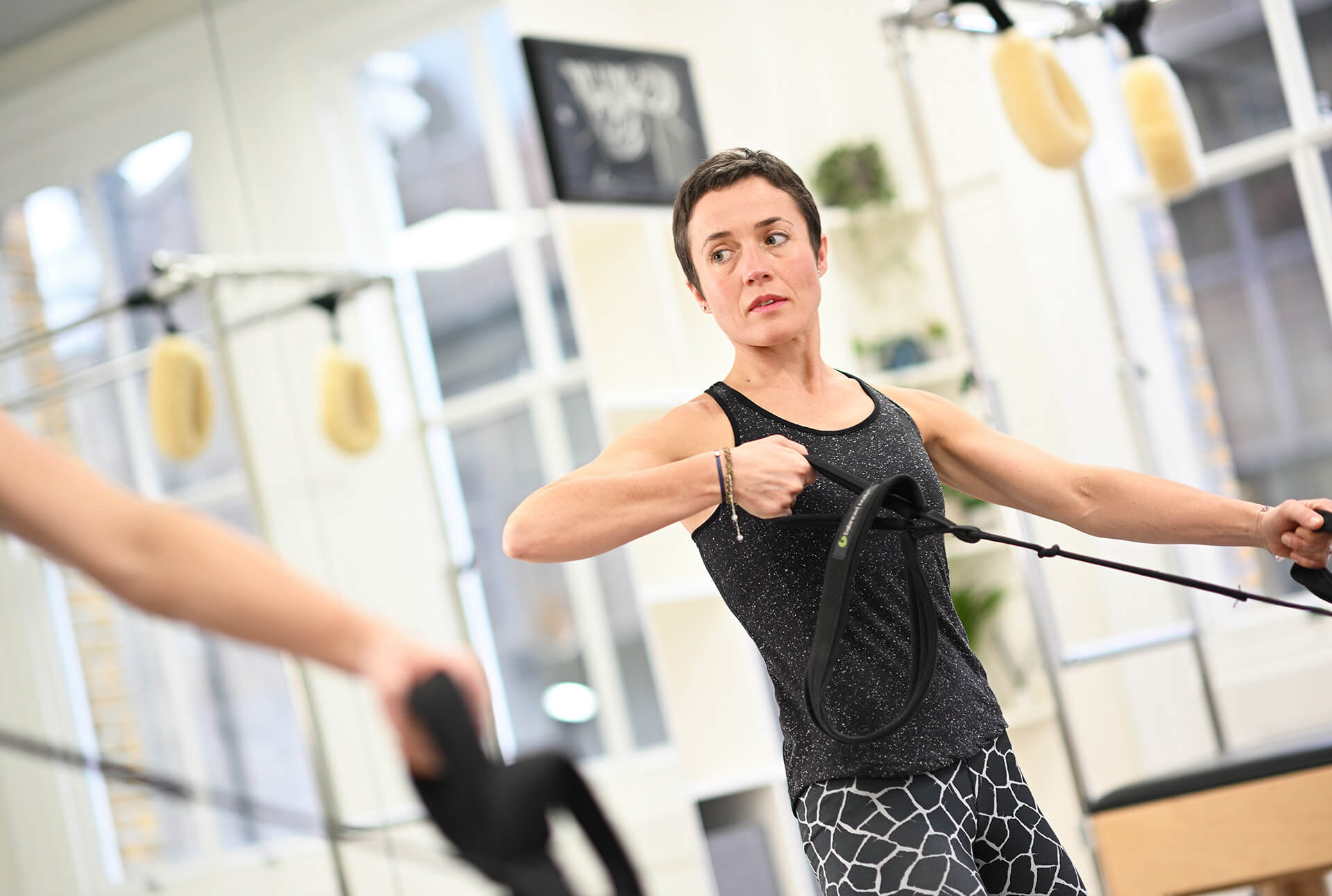COPD is a common lung disease that affects over 1 million people in the UK. The COPD foundation and the NHS recommend breathing exercises and maintaining an active lifestyle to help improve breathlessness fitness and quality of life.
In this article, we’ll be discussing:
- What is COPD?
- What are the symptoms of COPD?
- What are the benefits of breathing exercises for COPD
- What are the breathing exercises for COPD
- What are the best breathing exercises for COPD and asthma
- Exercising and COPD
- What exercises should you avoid if you have COPD
What Is COPD?
Chronic Obstructive Pulmonary Disease (COPD) is the name for a group of lung conditions that cause breathing difficulties. These diseases include emphysema and chronic bronchitis. COPD is a progressive and (currently) incurable disease, although the right diagnosis and treatment can help with the management of symptoms.
COPD is a condition that mainly affects middle-aged or older adults. In the UK, 1.2 million people are estimated to suffer from the disease. This makes it the second most common lung disease after asthma in the country.
Despite being a common disease, many people are living undiagnosed with the condition and as a result are not receiving the support they need. For sufferers, this is bad news. Without the right treatment, symptoms usually get worse – which is why increasing awareness of the disease is so important.
What Are The Symptoms Of COPD
Although symptoms can vary, these are the most common ones:
- Increasing breathlessness and shortness of breath
- Frequent coughing (with and without mucus)
- Frequent chest infections
- Persistent wheezing
- Tightness in the chest

What Are The Benefits Of Breathing Exercises For people with COPD
In the same way that aerobic exercise is beneficial for your heart and muscles, breathing exercises can be beneficial for the lungs and can help alleviate COPD symptoms and boost the strength of your lungs. Not only that, with regular practice they can help improve your ability to do daily activities and physical exercise which will fundamentally help make you feel more energetic overall.
Breathing exercises for COPD can help to:
- Reduce breathlessness
- Strengthen your breathing muscles so you can get more oxygen and breathe with less effort
- Manage episodes of breathlessness if they come on suddenly
- Manage anxiety
Exercising for people with COPD
For people with COPD, it can be easy to avoid activities that make you breathless. However, it is important to exercise to stay fit and healthy as this will help your breathing. Avoiding exercise will only make you less fit which will make your breathing worse.
A doctor or specialist Physiotherapist can prescribe the right level of activity for your condition.
For people with many different conditions, Pilates can be a great way to stay fit. Pilates is a slow, mindful and low-impact form of exercise. The main focus of Pilates is building strength and flexibility, meaning you rarely get out of breath while performing it.
What Are The Breathing Exercises For COPD?
Breathing techniques can help people with COPD reduce breathlessness. They can also help manage episodes of breathlessness if they come on suddenly.
Below are two simple breathing exercises recommended by the COPD foundation. For these techniques to be effective, it’s important to practise them regularly.
These exercises can be done at any time but do remember to speak to your GP, physio or a clinical Pilates instructor first should you be concerned about these exercises.
1. Pursed-Lips Breathing

Pursed-lips breathing is a popular breathing technique for people with COPD.
Anxiety is a common side-effect when people experience shortness of breath. But the panicked breathing that follows feelings of anxiety can make breathing even more difficult.
Pursed-lips breathing can help to slow down your breathing and make you feel calmer and more in control.
Performed properly, this breathing exercise can also help you take in oxygen more efficiently. According to studies, it can also help people with COPD exercise.
How To Do Pursed-Lips Breathing:
- Find a comfortable spot to sit and relax your shoulders.
- Breathe in through your nose with your mouth closed.
- Purse your lips as if about to blow out a candle.
- Breathe out very slowly through pursed lips until your lungs have emptied.
- Make the out breath longer than the in breath. It should be about twice as long. Counting your breath can help, so try two counts as you inhale and then four as you exhale.
- Repeat.
This technique should be practised for five – 10 mins each day.
2. Diaphragmatic Breathing
Diaphragmatic breathing, otherwise known as belly or abdominal breathing, is a popular technique for COPD sufferers. It is also commonly used in Pilates classes. As well as having a calming effect for some, this technique also helps people learn how to use their diaphragm properly to support their breathing.
Your Diaphragm and COPD
The diaphragm is the main muscle of breathing. It is supposed to do most of the work of moving air out of the lungs. In people with COPD, however, the diaphragm is weaker and doesn’t function properly.
As a result other muscles like those in the neck, shoulders and back have to do their job. These muscles aren’t as effective as the diaphragm, which causes the breathing in sufferers of COPD to weaken further.
Luckily, it is possible to strengthen the diaphragm muscle. Breathing exercises like the ones set out here can make the muscle stronger; this helps to improve the mechanics of breathing. This is good news for people with COPD, because people with stronger diaphragms cope better with the symptoms of the disease than those who have weaker ones.
How To Do Diaphragmatic Breathing:
- Start seated or lying down. Relax your shoulders.
- Place one hand on your belly and one hand on your upper chest.
- Focus your breathing on your belly.
- Breathe in and the hand on your belly should rise.
- Breath out and the hand on your belly should lower.
- Breathe in through your nose. Breathe out slowly. As with pursed-lips breathing, your exhalation should be longer than your inhalation.
- Challenge yourself once you’ve mastered this technique by trying it during an activity.
Practice this for about five to 10 minutes, two times a day.
Can I exercise with COPD?
For people with COPD, it can be easy to avoid activities that make you breathless.
However, it is important to exercise to stay fit and healthy as this will help your breathing. Avoiding exercise will only make you less fit which will make your breathing worse.
A doctor or specialist Physiotherapist can prescribe the right level of activity for your condition.
Pilates and COPD
For people with many different conditions, Pilates can be a great way to stay fit. Pilates is a slow, mindful and low-impact form of exercise.
The main focus of Pilates is building strength and flexibility, meaning you rarely get out of breath while performing it.
The breath is one of the main principles of Pilates and is considered as an integral part of movement. We have talked about the diaphragm and its role in breathing but it is also part of the core along with the abdominals, spinal muscles, and pelvic floor. Working the core with Pilates will help to support and strengthen the diaphragm and therefore help you breathing.
The breath is also used in Pilates to assist movement. For example, the inflation of the lungs can help spinal extension and rib movement. As we exhale the deflation and activation of the core can help with flexion of the spine and movement of the limbs.
These factors make Pilates suitable for most people with COPD. It can help to improve overall strength and endurance as well as strengthen the muscles you use to breathe. If you do suffer with COPD and are considering starting a Pilates programme, do check with your health care professional first.
Here are two Pilates exercises you may have done before, try focusing on the breath and see if they feel different.
1. Mermaid
This video gives you a full tutorial on this movement.
You will be sitting and just need a mat and possibly a cushion to sit on.
Focus on the breathing cues that you are given through each part of the Pilates mermaid.
Top tips
- Sit heavy through your hips on each side
- You can also try a version of this sat in a chair
- Focus the breath into the ribs on the side you are stretching
- Use the inflation of the lungs to try and lift yourself taller
2. Cat cow
This is a great Pilates exercise for seeing how your breath can make a difference.
Again, all you need is a mat, you can also do this in standing leaning forwards with your hands on a table.
Top tips
- Breath in as you arch your back with the chest lifted
- Breath out as you lift the back and drop the head
- Think about aiming the breath into your back as you flex
- Try aiming the breath into your chest as you extend
Exercises To Avoid If You Have COPD
If you have COPD then it may be recommended you avoid heavy lifting or pushing, chores such as shovelling, mowing, or raking, push-ups, sit-ups, outdoor exercises when the weather is very cold, hot, or humid and walking up steep hills. As always this will depend on your individual case and can be discussed with your health care professional. People with COPD should pace themselves and balance activity with rest.
It’s best to consult with your doctor or health practitioner whether other exercises such as weightlifting, running and swimming are okay for you to do.
Why You Should Consider Breathing Exercises If You Have COPD
As highlighted in this article breathing exercises for COPD or asthma can help improve oxygen use, muscle strength, and cardiovascular health. They can also reduce anxiety, stress, and depression, as well as shortness of breath.
If you are worried about starting a new exercise, such as breathing techniques, we would always recommend you speak to your GP, physio, or clinical Pilates instructor here at Complete Pilates first who are all trained to safely create manageable plans to keep your spine healthy.
Join us at our Pilates Studios
Are you based in London? Do you need guidance on COPD breathing and exercises? If so, why not join us at our Pilates studio in Fulham road, our North London Pilates studio or book a personalised 1-2-1 session at Complete Pilates London City.
Resource link:
- https://www.asthmaandlung.org.uk/conditions/copd-chronic-obstructive-pulmonary-disease/what-can-you-do-manage-your-copd (Asthma & Lung UK)
- https://www.nhs.uk/conditions/chronic-obstructive-pulmonary-disease-copd/living-with/ (NHS, Living with COPD)
- https://www.copdfoundation.org/What-is-COPD/Understanding-COPD/What-is-COPD.aspx
Get in touch online or contact us on 0203 764 5668 for further information and advice!
Education is key:
These blogs are designed to give information to everyone, however, it is important to remember that everyone is different! If you have not seen one of our therapists and have any questions about injuries, what you have read or whether this may be useful to you, please just ask. We are more than happy to help anyone and point you in the right direction. Our biggest belief is that education is key. The more you understand about your injury, illness and movement, the more you are likely to improve.



